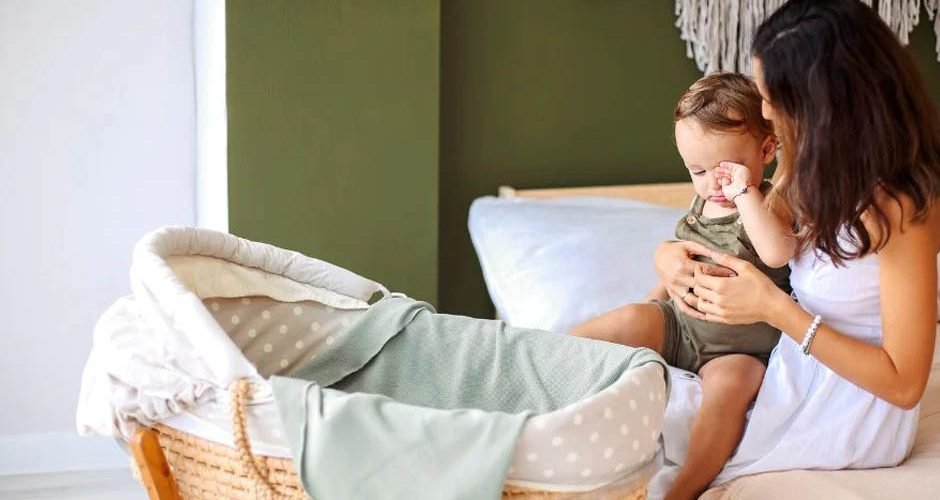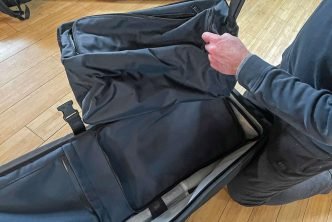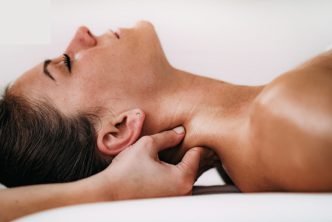Buying your baby’s first bed is a huge milestone in your pregnancy and parenthood journey. With so many options available on the market, it can be overwhelming to know where to start with your search for the ideal bed.
One of the biggest questions new parents ask is whether they should get a crib or a Moses basket as their baby’s first bed. We’re going to compare the two to help you make the decision that’s best for you and your baby.
Table of Contents
Crib vs Moses Basket: Which is Best for Your Baby?
Cribs are an excellent choice for a baby’s first bed due to their sturdy construction and long-term usage potential. With adjustable mattress heights and the ability to convert into a toddler bed, a crib can provide a comfortable sleeping environment for your child for several years. Cribs are also designed with safety in mind, featuring slats that are close together to prevent your baby from getting their head or limbs stuck.
Moses baskets, on the other hand, offer portability and convenience. These lightweight, compact baskets can be easily moved from room to room, allowing parents to keep their newborn close at all times. The snug and cosy design of a Moses basket can also provide a comforting environment for newborns, mimicking the close confines of the womb. Additionally, Moses baskets often come with a hood or cover, offering additional protection from bright light and drafts.
Understanding Crib Sizes and Features
Cribs come in a variety of sizes and styles. The standard crib size measures approximately 28 inches x 52 inches, providing ample space for your baby to move and roll around comfortably. Convertible cribs can be transformed into toddler beds and, eventually, into full-size beds. These cribs are an economical choice for parents considering long-term use.
Mini cribs are smaller than standard cribs, typically measuring around 24 inches x 38 inches. They are perfect for smaller rooms or for parents who want to maximise their space. Despite their smaller size, many mini cribs are still adjustable and can fit a child comfortably till they are ready for a toddler bed.
A particular type of crib worth mentioning is the bedside crib. It’s designed to align with the parent’s bed, offering a convenient and easy reach to the baby during nighttime nursing or soothing. Bedside cribs often feature a retractable side wall, enabling easy access to the baby without the need to leave your bed. This style of crib provides the benefits of co-sleeping while ensuring that the baby has their own safe, separate space. Bedside cribs might also have adjustable height settings, lockable wheels for mobility, and breathable mesh sides for optimum ventilation.
Safety Tips for Baby’s Sleep Space
Creating a safe sleep space for your baby is of utmost importance to prevent injuries and reduce the risk of Sudden Infant Death Syndrome (SIDS). A safe sleep environment ensures that your baby will not be exposed to potential hazards such as suffocation or strangulation. It also helps establish good sleep habits early in life, contributing to a baby’s overall health and well-being. Consequently, it is crucial for parents to educate themselves on what constitutes a safe sleep space and to regularly check the baby’s sleeping area for any potential dangers.
Setting Up and Maintaining Sleep Spaces
Setting up and maintaining a baby’s sleep space requires careful attention to safety. First and foremost, place the crib, bassinet, or Moses basket on a flat and stable surface away from windows, blind cords, or heavy furniture that could potentially pose a risk. Choose a firm mattress that fits the sleep space without any gaps, and cover it with a fitted sheet. Avoid adding any soft objects like pillows, blankets, or plush toys into the baby’s sleep area, as they can increase the risk of suffocation.
Regular maintenance is also crucial. Periodically check the sleep space for any loose screws, peeling paint, or breakages. If you’re using a crib, make sure that the space between the slats is no more than 2-3/8 inches (approximately 6 centimetres) to prevent the baby’s head from getting trapped. Clean the sleep space regularly with non-toxic cleaners to keep it free from dust and allergens. Always keep the area well-ventilated. Remember, a safe sleep environment is pivotal for your baby’s well-being.
Considerations for Size and Portability
Of course, the features of a crib aren’t the only thing you need to consider when looking at purchasing a crib. New parents also have to think about the size of the crib or Moses basket to ensure it fits in the nursery space. The portability of the crib is also important. Moses baskets are known to be easily transported around the house or for travelling, but cribs are less likely to have the same ability.
Planning for the Future: Transitioning Beds
Convertible or transitioning beds present an economical choice for parents as they grow with the child, negating the need for multiple purchases over time. Beginning as a crib, they can transform into a toddler bed, day bed, and finally, a full-sized bed. This adaptability saves not only money but also time and effort spent on selecting and setting up new furniture.
Matching Your Nursery Style
In recent years, the range of cribs and Moses baskets has expanded dramatically, offering parents a wider selection to match their nursery’s aesthetic. From traditional to modern, rustic to sleek, there’s a design to suit every taste and style. Parents can opt for a vintage carved wooden crib for a classic, timeless look or a minimalist Moses basket for a more contemporary nursery.
The variety is not limited to structure but also includes colour and material options. Cribs and Moses baskets now come in a multitude of shades and finishes, from natural wood to painted pastels, allowing the baby’s first bed to seamlessly blend in or stand out in the nursery decor.
Choosing the perfect crib or Moses basket is an exciting and important task. As you explore the multitude of options available, consider not just aesthetics but also the size, portability, and potential for future adaptability. With careful selection, this first piece of furniture can provide a safe, comfortable, and stylish environment for your baby’s early years.
FAQs
Is A Moses Basket Or Bedside Crib Better?
The choice between a Moses basket and a bedside crib depends on personal preference and specific needs. A Moses basket is portable, which makes it convenient for moving around the house. A bedside crib, on the other hand, enables easier nighttime feedings and closeness to the baby without sharing the same bed. Both offer a secure space for the baby, so consider factors like space, convenience, and your lifestyle when making a decision.
Can You Put A Moses Basket In A Crib?
Absolutely! Placing your baby’s Moses basket in their crib is a great way to begin transitioning them from sleeping in the Moses basket to sleeping in the crib full time. Allowing them to sleep in the Moses basket in the crib gives your baby a chance to get used to their new sleep space while surrounded by familiar sights and materials.
Is A Crib Good For A Newborn?
A crib makes a perfectly good bed for your newborn baby. For the first 6 months, you should place the crib in your bedroom to help reduce the risk of SIDS. You should also make sure you’re adhering to safe sleep practices with the crib. Make sure there are no loose blankets, your baby can’t get to the bars, and they’re correctly swaddled or in a sleeping bag.





